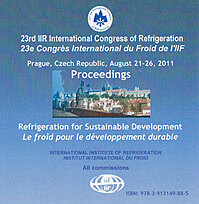
Document IIF
Évaluation d'un système à pompe à chaleur géothermique pour faire varier les charges et les températures de retour de l'eau en utilisant divers facteurs de performance des systèmes.
Evaluation of a ground source heat pump system for varying loads and return water temperatures using different system performance factors.
Numéro : pap. ID: 653
Auteurs : EDWARDS K. C., JONES A. T., FINN D. P.
Résumé
A quasi-steady state mathematical model of a ground source heat pump has been developed. Heating and cooling is delivered to the building using fan coil units, which are either in constant operation (Strategy 1) or switched on/off as water flow to the coil is diverted (Strategy 2). The performance of the system is evaluated using a system performance factor (SPF). It was observed that valves for SPF4 (which includes all components) decreases for decreasing building load. For Strategy 2, the energy saving associated with SPF4 are greater than Strategy 1, but savings are diminished at higher loads. Improved system performance was observed at lower return water temperatures in heating and higher temperatures in cooling. However, in both cases the capacity of the fan coil units is reduced. The temperature compensation strategy developed resulted in an improved SPF4 for Strategy 1 and a less significant improvement for Strategy 2.
Documents disponibles
Format PDF
Pages : 8 p.
Disponible
Prix public
20 €
Prix membre*
Gratuit
* meilleur tarif applicable selon le type d'adhésion (voir le détail des avantages des adhésions individuelles et collectives)
Détails
- Titre original : Evaluation of a ground source heat pump system for varying loads and return water temperatures using different system performance factors.
- Identifiant de la fiche : 30002107
- Langues : Anglais
- Source : Proceedings of the 23rd IIR International Congress of Refrigeration: Prague, Czech Republic, August 21-26, 2011. Overarching theme: Refrigeration for Sustainable Development.
- Date d'édition : 21/08/2011
Liens
Voir d'autres communications du même compte rendu (569)
Voir le compte rendu de la conférence
-
Evaluation of the annual performance of ground ...
- Auteurs : MADANI H., LUNDQVIST P.
- Date : 21/08/2011
- Langues : Anglais
- Source : Proceedings of the 23rd IIR International Congress of Refrigeration: Prague, Czech Republic, August 21-26, 2011. Overarching theme: Refrigeration for Sustainable Development.
- Formats : PDF
Voir la fiche
-
Energy Performance Comparison of Two Different ...
- Auteurs : LEE J. H., LIM H., DONG H. W., JEONG J. W.
- Date : 31/08/2021
- Langues : Anglais
- Source : 13th IEA Heat Pump Conference 2021: Heat Pumps – Mission for the Green World. Conference proceedings [full papers]
- Formats : PDF
Voir la fiche
-
Comprehensive modeling of a chemical looping he...
- Auteurs : KIM J., BRAUN J. E., GROLL E. A., ZIVIANI D.
- Date : 05/2021
- Langues : Anglais
- Source : 2021 Purdue Conferences. 18th International Refrigeration and Air-Conditioning Conference at Purdue.
- Formats : PDF
Voir la fiche
-
An air-water dual-source heat pump system for s...
- Auteurs : CHENG J. H., GAO P., CAO X., SHAO P., SHAO L. L., ZHANG C. L.
- Date : 31/08/2021
- Langues : Anglais
- Source : 13th IEA Heat Pump Conference 2021: Heat Pumps – Mission for the Green World. Conference proceedings [full papers]
- Formats : PDF
Voir la fiche
-
Application of multipurpose heat pumps in museu...
- Auteurs : SCHITO E., CONTI P., TESTI D.
- Date : 15/05/2023
- Langues : Anglais
- Source : 14th IEA Heat Pump Conference 2023, Chicago, Illinois.
- Formats : PDF
Voir la fiche
